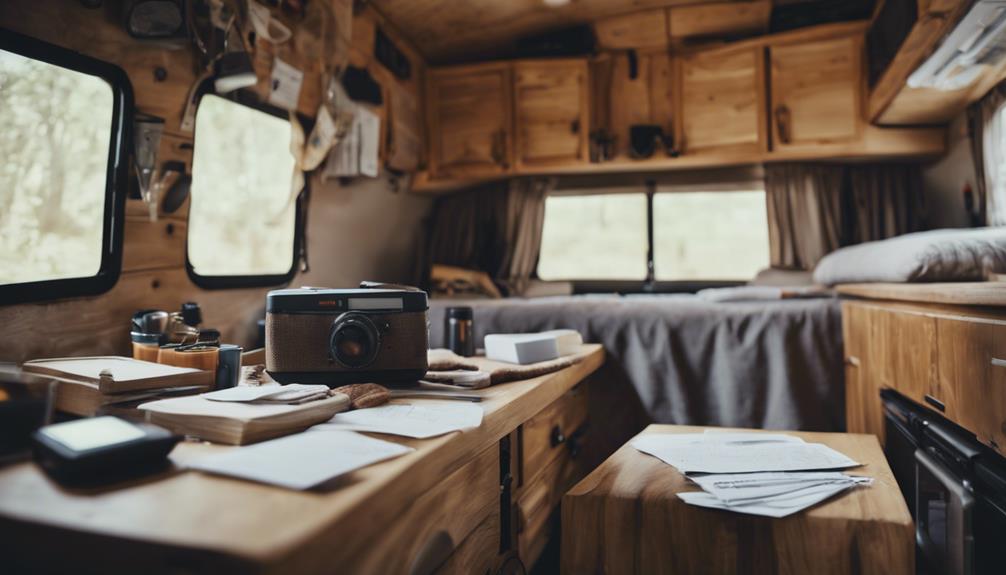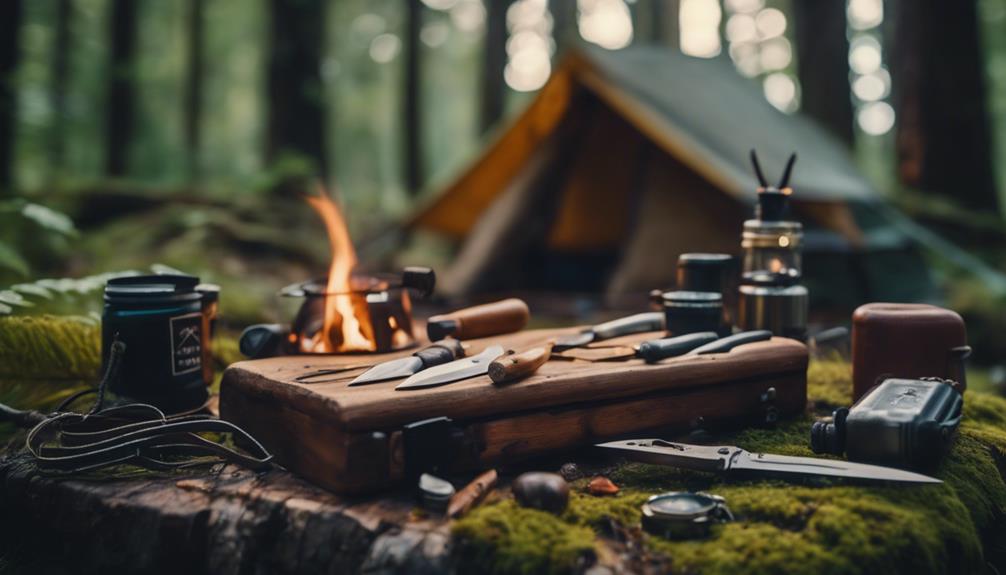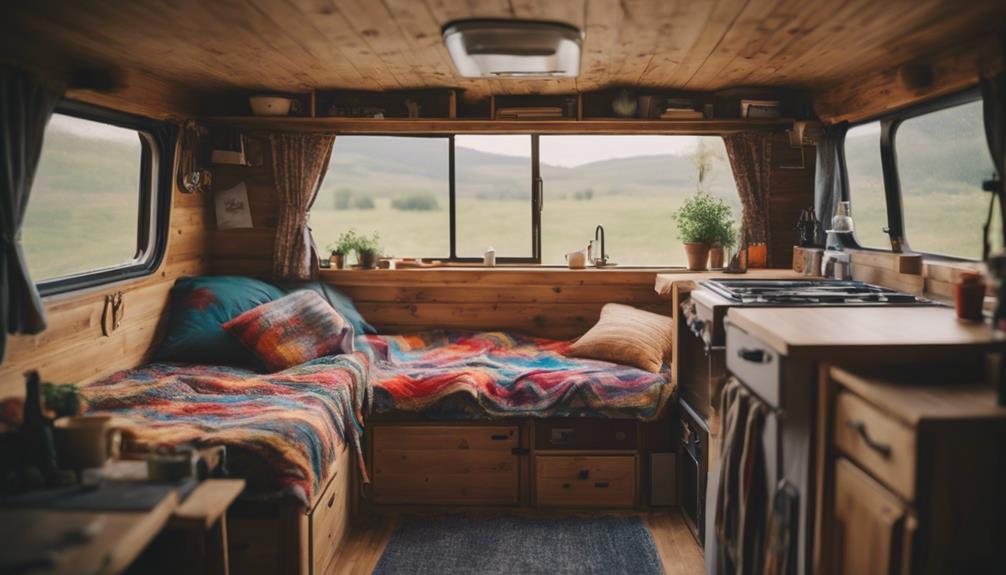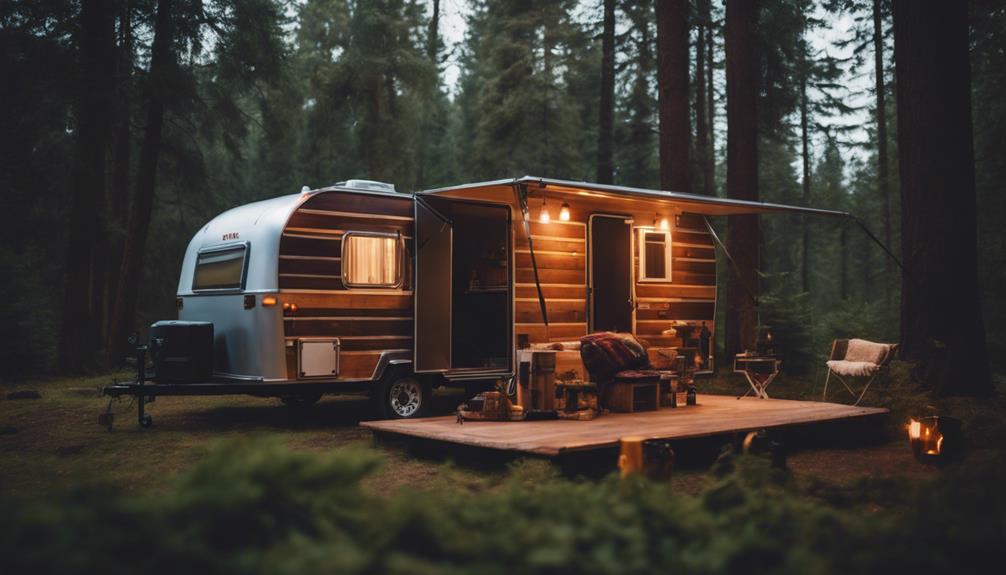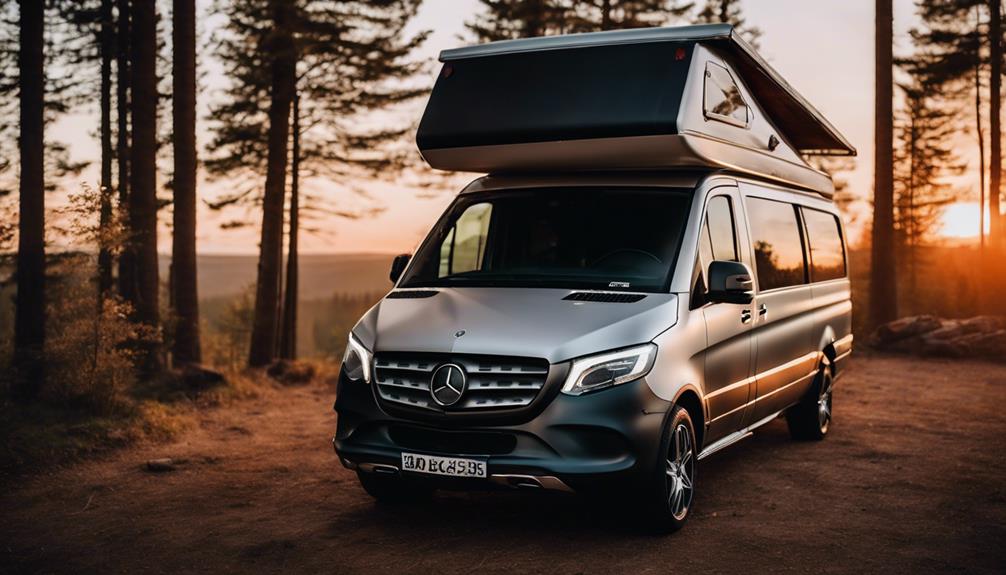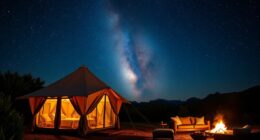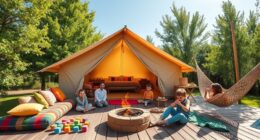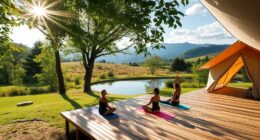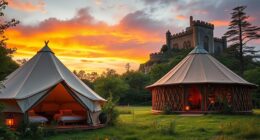A camper conversion can cost between $10,000 for a basic DIY build and over $250,000 for top-tier professional designs. To budget wisely, allocate about 50-60% for the van purchase and 40-50% for the conversion itself. Don't forget to set aside an extra 10-15% for unexpected expenses, especially if you're using an older vehicle. Essential systems, like electrical or plumbing, can add $1,200 to $5,000 to your costs. Exploring thrift stores and local classifieds for materials can also help you save. Keep going to discover more valuable tips for your camper conversion journey.
Introduction
When starting on a camper conversion, understanding the potential costs and budgeting wisely can make all the difference in turning your vision into reality. The costs of camper van conversions can vary widely, from basic DIY builds around $10,000 to elaborate professional designs exceeding $250,000.
To guarantee you stay on track, it's vital to set a budget that allocates 50-60% for the van purchase and 40-50% for the conversion itself.
Keep in mind that van conversion costs can escalate due to essential systems like electrical and plumbing setups, which can run anywhere from $1,200 to $5,000. It's wise to budget an additional 10-15% for unexpected expenses that may arise during your conversion project, such as insulation or hidden costs.
You can mitigate these expenses by utilizing second-hand materials and embracing DIY conversion strategies, making the process more budget-friendly.
Ultimately, your conversion depends on how well you plan and anticipate costs. By understanding the financial landscape of your camper conversion, you'll be better equipped to create the mobile home of your dreams without breaking the bank.
Background Information
Since the 1970s, van conversions have evolved into a popular way to travel and live on the road.
You'll find that modular designs have emerged, allowing for more flexibility in how you customize your space.
Understanding this history can help you make informed choices for your own camper conversion budget.
Van Conversions Since the 1970S
Van conversions have consistently captured the imagination of adventurers since the 1970s, largely thanks to the iconic Volkswagen Type 2, which became a symbol of the DIY movement during that era. As a DIY enthusiast, you might appreciate how the growing interest in road trips and outdoor adventures spurred the campervan lifestyle.
Early van conversions focused on basic living necessities, like sleeping areas and simple cooking facilities, reflecting a minimalist lifestyle.
Throughout the 1980s and 1990s, advancements in materials and technology led to more sophisticated builds. You could find mobile kitchens and improved insulation in these customized vehicles, enhancing comfort on the road.
Today, modern van conversions cater to a wide range of needs, from basic camping setups to full-time living solutions. The evolution of these conversions means you can create a space tailored to your adventures, whether you're looking for a simple getaway or a more elaborate setup.
Embracing the campervan lifestyle allows you to explore the world while enjoying the comforts of home on wheels, making it an appealing choice for many outdoor enthusiasts.
Emergence of Modular Designs
Modular designs in camper conversions have revolutionized how you can personalize your living space, offering customizable layouts that adapt to your unique needs and preferences. These designs often feature pre-fabricated components that are easy to assemble and disassemble, allowing you to modify your setup without extensive renovations.
With modular systems, you benefit from enhanced space efficiency, which is essential in the confined areas of a camper. You'll discover innovative storage solutions and multi-functional furniture, maximizing every inch without sacrificing comfort. Whether you need a simple bed setup or a more complex arrangement with integrated technology, these options cater to various budgets, making them accessible for everyone.
Moreover, modular designs are cost-effective, helping you manage your expenses more efficiently. You can purchase only the components you need and upgrade gradually, keeping your camper conversion within budget. Many companies now offer specialized conversion kits tailored to diverse requirements, ensuring you find the perfect fit for your lifestyle.
Embracing modular designs not only streamlines your camper conversions but also empowers you to create a space that truly reflects your individuality.
Recent Design Innovations
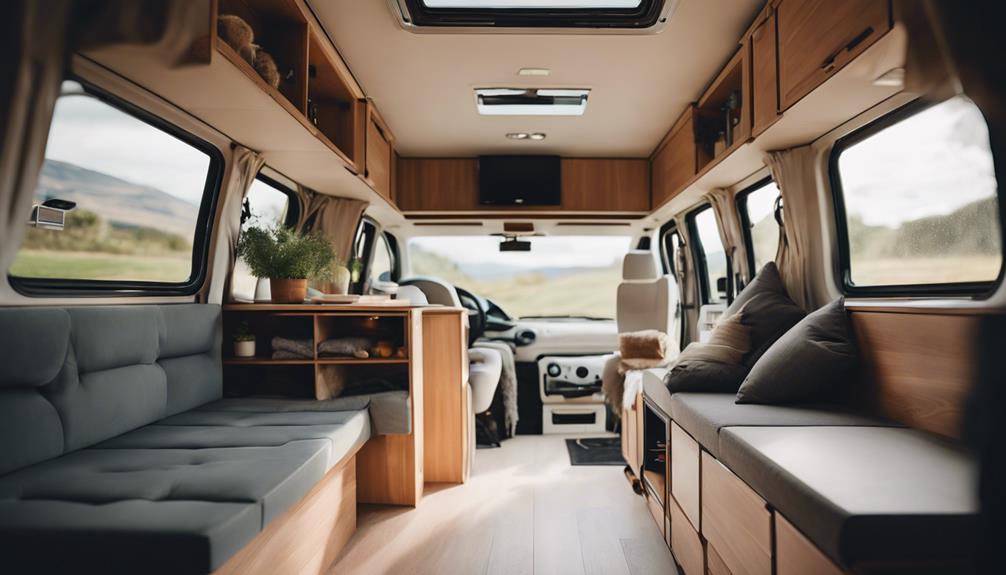
When you think about recent design innovations in camper conversions, customizable modular interior designs stand out.
These systems let you adapt your space based on your needs, making your camper truly yours.
Plus, eco-friendly insulation options not only keep you comfortable but also contribute to a more sustainable lifestyle.
Customizable Modular Interior Designs
Innovative customizable interior designs in camper conversions let you tailor your space to fit your unique lifestyle and preferences.
With recent advancements in modular designs, you can easily reconfigure your living area as your needs change. These designs often include versatile, multi-functional components like foldable beds and removable storage units, maximizing utility without sacrificing comfort.
If you're working with a budget, pre-fabricated kits are a great option. Available for various van models, these kits typically range from $1,500 to $5,000, allowing you to choose features that suit your style.
Many of these kits utilize lightweight materials, such as composites and sustainable wood alternatives, enhancing durability while improving fuel efficiency.
Eco-Friendly Insulation Options
Exploring eco-friendly insulation options can greatly enhance your camper's energy efficiency while minimizing your environmental impact.
Consider materials like sheep's wool, which not only provides excellent thermal performance but also offers humidity regulation and is both biodegradable and sustainable.
Another innovative choice is recycled denim insulation, made from post-consumer waste, which delivers good thermal resistance and sound absorption with a lower environmental footprint than traditional fiberglass.
Cork insulation is another fantastic option, as it's harvested from the bark of cork oak trees, boasting natural fire resistance and effective humidity regulation.
If you're looking for something with a high R-value, plant-based spray foam insulation, made from soy or other natural materials, can effectively insulate while reducing your reliance on petroleum-based products.
Lastly, mycelium-based insulation, created from agricultural byproducts and mushroom roots, provides a fully compostable solution with impressive insulation properties.
Cost-Benefit Evaluation
When you evaluate the cost-benefit of your camper conversion, consider how much value you'll gain from your investment.
Analyzing cost versus value, exploring insights from industry experts, and comparing material costs can help you make informed decisions.
Ultimately, understanding these factors will guide you in creating a conversion that meets your needs without breaking the bank.
Cost Vs. Value Analysis
Evaluating a camper conversion's cost versus value means weighing your initial investment against the long-term benefits of savings on travel expenses. Your upfront cost can range markedly, from around $10,000 for basic builds to over $100,000 for high-end customizations. If you plan to travel extensively or live in your van, those higher upfront costs might be justified by considerable long-term savings on accommodations and dining.
Customization plays an essential role in this evaluation. High-quality materials not only enhance durability but can also boost resale value, providing greater overall value. DIY conversions can save you on labor costs, making them an attractive option if you have the skills. Meanwhile, professional builds often deliver superior craftsmanship and efficiency, potentially increasing your return on investment.
When considering features like solar panels or high-efficiency appliances, think about how these additions will impact your future savings and comfort. Ultimately, analyzing the cost versus value of your camper conversion helps guarantee you make informed decisions, maximizing both your investment and your enjoyment of van life.
Industry Expert Insights
Industry experts emphasize the importance of carefully evaluating both immediate costs and long-term benefits when planning your camper conversion. You'll want to allocate about 50% to 60% of your budget for the van purchase and 40% for the actual conversion.
Whether you're considering DIY conversions or professional conversions, understanding conversion costs is vital. DIY options can range considerably, from $4,082 to over $96,892, depending on your customization levels. On the other hand, professional conversions start at around $30,000, offering quality guarantees but at a higher price.
Don't overlook essential systems such as electrical and water setups, which can add between $1,200 and $5,000 to your budget. Additionally, be mindful of hidden costs, like registration and repairs; it's wise to set aside an extra 10-15% for contingencies.
As you navigate this process, verify you're financially stable to handle any unexpected expenses that may arise. Taking these budgeting tips into account will help you create a camper van conversion that meets your needs while keeping your finances on track.
Cost Comparison of Materials
Choosing the right materials for your camper conversion can profoundly impact both your budget and the overall quality of your build. Conducting a thorough cost comparison of materials is essential for maximizing budget efficiency. Basic wall finishes can set you back between $50-$150, while specialized options might run from $250-$500. For flooring, laminate typically costs about $45 per box, totaling around $275, which offers great durability and style.
If you're a DIY builder, consider plywood for furniture and cabinetry, priced at $40-$100 per sheet, making it a cost-effective choice. You can also find second-hand materials at thrift stores or Habitat ReStore, greatly lowering your overall costs. This approach not only enhances budget efficiency but also adds a unique touch to your build.
Investing in quality insulation might raise your upfront costs, but it ultimately pays off in energy efficiency and comfort. Weighing these factors helps you make informed decisions that balance initial expenses with long-term benefits, ensuring your camper conversion aligns with both your budget and desired functionality.
Budget-Friendly Material Choices
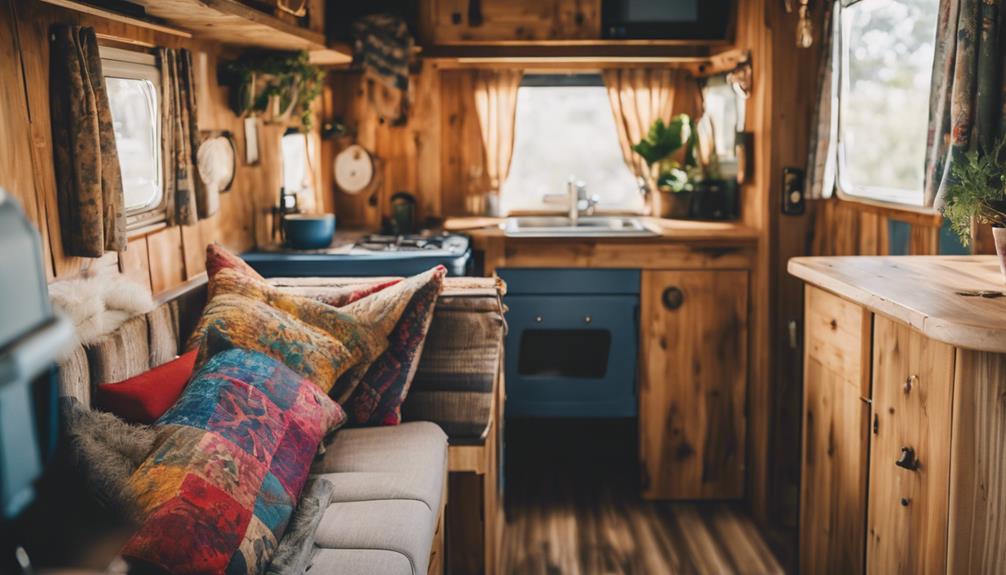
When you're planning your camper conversion, budgeting for essential materials is key to keeping costs low.
You can find affordable materials by exploring thrift stores, online classifieds, and even repurposing old furniture.
Budgeting for Essential Materials
Finding budget-friendly materials for your camper conversion can drastically cut costs and help you stay within your budget. When it comes to essential materials, consider second-hand options from local thrift stores or Habitat for Humanity ReStore. This strategy can save you 30-50% on interior finishes compared to buying new.
Basic wall finishes can be achieved for as little as $50, while more specialized ones may range up to $500, allowing you to customize based on your van conversion cost.
For furniture and structural components, plywood sheets typically cost between $40-$100, offering an economical choice for building bed platforms and cabinets. When it comes to flooring, laminate averaging $45 per box gives you a stylish finish for about $275 total, making it an affordable option.
Don't forget about repurposing old furniture or using recycled materials for storage solutions. These DIY projects can often be completed for around $100, saving money while reducing waste.
Affordable Material Sourcing Strategies
Exploring local classifieds and thrift stores can lead you to affordable materials that enhance your camper conversion without straining your budget. Platforms like Craigslist and Facebook Marketplace often list gently used materials and furniture, making them an affordable option for you. When you visit thrift stores or Habitat for Humanity ReStores, you'll find a treasure trove of building supplies and unique materials that can elevate your van's aesthetic.
Repurposing old items, such as pallets or scrap wood, not only saves you money but also adds character to your space. You can create custom furniture or decor that reflects your personal style.
For essential building materials, consider using budget-friendly options like vinyl flooring and plywood. These materials aren't only cost-effective but also durable, ensuring your camper stands the test of time.
Additionally, don't overlook the potential of used materials. They can provide significant savings while still delivering quality. For lighting, battery-powered LED lights are an economical solution, giving you sufficient illumination without high energy costs.
What are some budgeting tips for a camper conversion?
When planning a camper conversion, it’s essential to create a camper conversion cost breakdown to get an accurate picture of your expenses. Start by setting a budget and stick to it. Opt for affordable materials and do as much DIY work as possible. Don’t overspend on unnecessary features.
Conclusion
Successfully steering through the costs of a camper conversion requires careful planning and budgeting to guarantee your dream van becomes a reality.
Whether you opt for a DIY approach or hire a professional, understanding your conversion budget is vital. A basic DIY camper conversion can range from $10,000 to $20,000, while professional conversions can start at $30,000 and soar past $250,000 based on your desired features.
Allocate 50-60% of your budget for the van purchase and 40-50% for the conversion itself. It's important to recognize that expenses, especially for systems like electrical setups, can add up considerably, often ranging from $1,200 to $5,000.
To avoid surprises, set aside an extra 10-15% of your budget for unexpected costs, particularly for older vans that may need repairs.
Incorporating second-hand materials into your build can lead to a more budget-friendly conversion while allowing you to focus on key features. By planning wisely and being resourceful, you can create a comfortable and functional camper without breaking the bank.
With the right approach, your camper conversion can be both affordable and tailored to your needs.
Frequently Asked Questions
How Much Does It Cost to Do a Campervan Conversion?
A campervan conversion can cost anywhere from $10,000 to over $250,000, depending on whether you DIY or hire professionals. Customization and essential systems will greatly influence your overall budget, so plan wisely!
How Much Should I Budget for a Van Conversion?
You should budget between $10,000 and $20,000 for a DIY van conversion, allocating 50-60% for the van and the rest for conversion costs. Don't forget to set aside an extra 10-15% for unexpected expenses.
Is It Worth Converting a Campervan?
Deciding if it's worth converting a campervan depends on your travel frequency and lifestyle. If you'll use it often, the comfort and customization can enhance your experience, making the investment truly worthwhile.
How Much Does It Cost to Maintain a Campervan?
Maintaining a campervan can cost you between $1,000 to $2,000 annually for upkeep, plus monthly gas expenses ranging from $200 to $600. Don't forget about insurance and campsite fees, which can add up quickly.
Conclusion
To summarize, budgeting for a camper conversion doesn't have to be overwhelming.
By considering recent design innovations and opting for budget-friendly materials, you can create a space that fits your needs without breaking the bank.
Remember to evaluate the costs versus the benefits carefully, ensuring you invest in features that truly enhance your experience.
With a clear plan and some creativity, you'll be well on your way to enjoying your personalized camper adventure!

